Strategic Crisis Communication Plan for Malaysia Airlines MH370
VerifiedAdded on 2023/06/03
|13
|3628
|277
Report
AI Summary
This report analyzes the crisis communication strategies employed by Malaysia Airlines (MAS) following the disappearance of flight MH370. It elaborates on the impact of the crisis, including the negative public reaction to the airline's initial communication efforts. The report then presents a detailed crisis communication plan, outlining key elements such as documentation procedures, the establishment of an Emergency Operation Centre (EOC), the formation of a Core Crisis Management Team with defined responsibilities, resource requirements, crisis procedures, spokesperson selection, and communication protocols for engaging stakeholders. The plan emphasizes the importance of transparency, promptness, and empathy in communication, as well as the utilization of social media platforms for disseminating information and gathering feedback. The report concludes by stressing the need for Malaysia Airlines to improve its crisis response procedures to ensure passenger safety and maintain public trust. Desklib offers a wealth of similar resources for students.
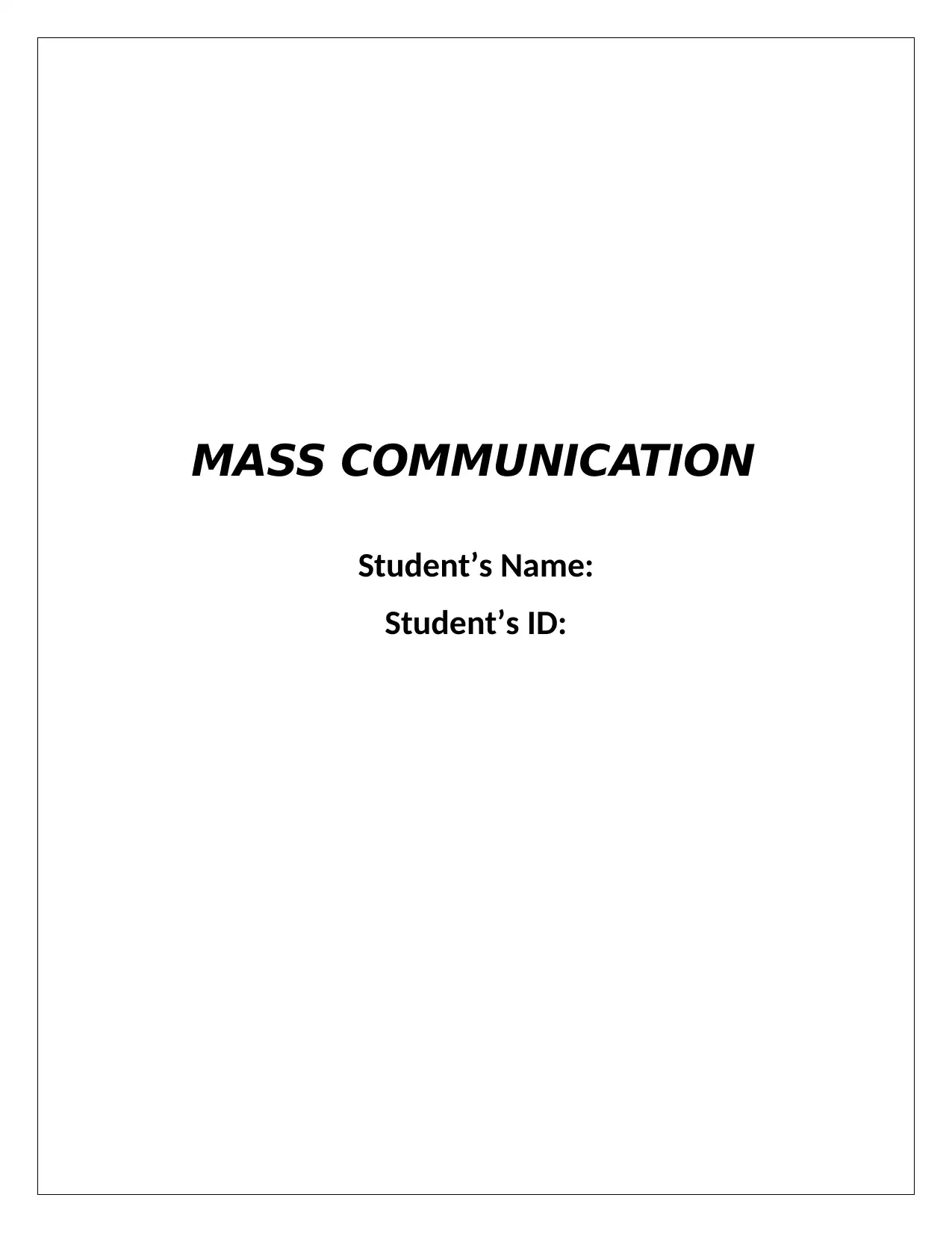
MASS COMMUNICATION
Student’s Name:
Student’s ID:
Student’s Name:
Student’s ID:
Paraphrase This Document
Need a fresh take? Get an instant paraphrase of this document with our AI Paraphraser
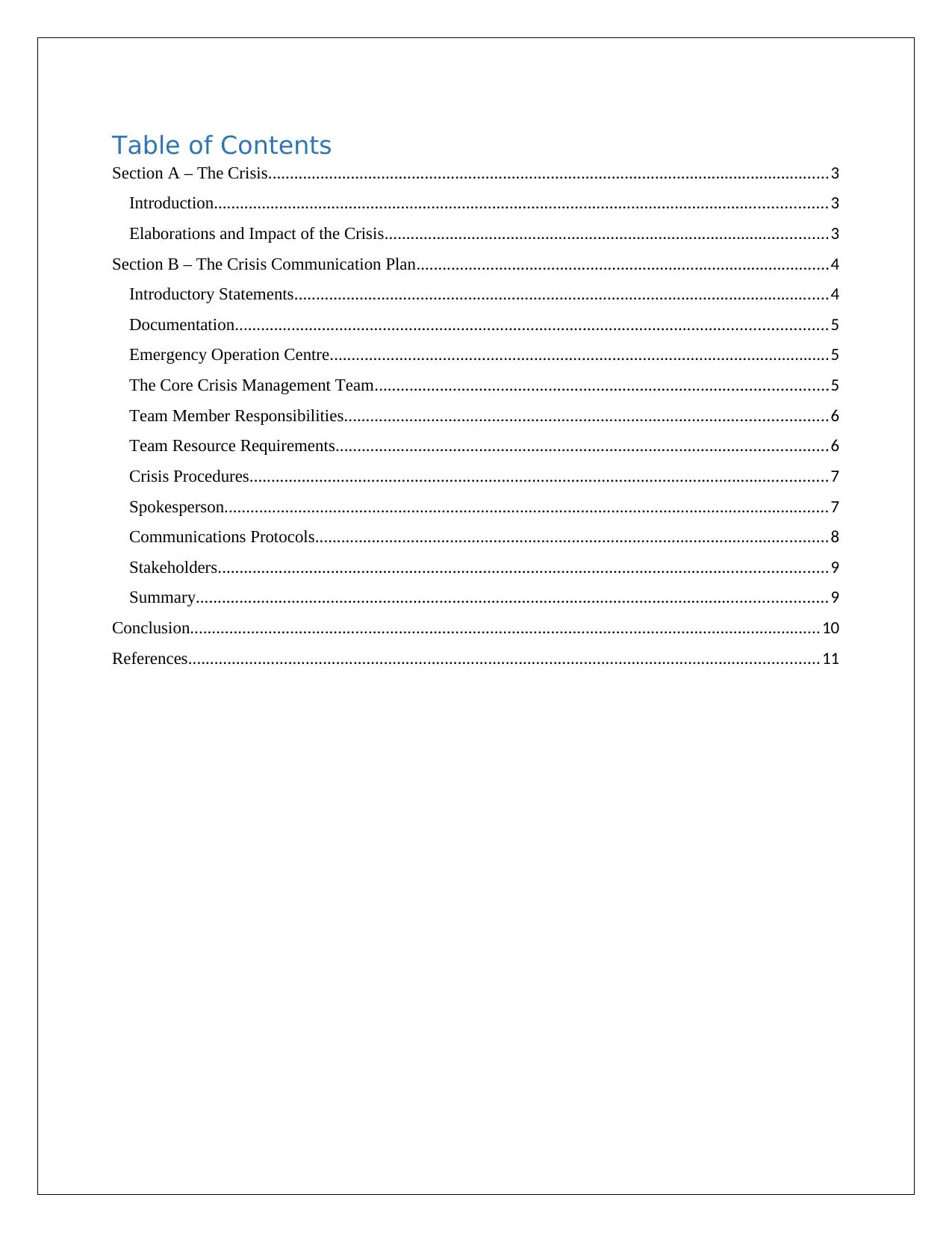
Table of Contents
Section A – The Crisis.................................................................................................................................3
Introduction.............................................................................................................................................3
Elaborations and Impact of the Crisis......................................................................................................3
Section B – The Crisis Communication Plan...............................................................................................4
Introductory Statements...........................................................................................................................4
Documentation........................................................................................................................................5
Emergency Operation Centre...................................................................................................................5
The Core Crisis Management Team........................................................................................................5
Team Member Responsibilities...............................................................................................................6
Team Resource Requirements.................................................................................................................6
Crisis Procedures.....................................................................................................................................7
Spokesperson...........................................................................................................................................7
Communications Protocols......................................................................................................................8
Stakeholders............................................................................................................................................9
Summary.................................................................................................................................................9
Conclusion.................................................................................................................................................10
References.................................................................................................................................................11
Section A – The Crisis.................................................................................................................................3
Introduction.............................................................................................................................................3
Elaborations and Impact of the Crisis......................................................................................................3
Section B – The Crisis Communication Plan...............................................................................................4
Introductory Statements...........................................................................................................................4
Documentation........................................................................................................................................5
Emergency Operation Centre...................................................................................................................5
The Core Crisis Management Team........................................................................................................5
Team Member Responsibilities...............................................................................................................6
Team Resource Requirements.................................................................................................................6
Crisis Procedures.....................................................................................................................................7
Spokesperson...........................................................................................................................................7
Communications Protocols......................................................................................................................8
Stakeholders............................................................................................................................................9
Summary.................................................................................................................................................9
Conclusion.................................................................................................................................................10
References.................................................................................................................................................11
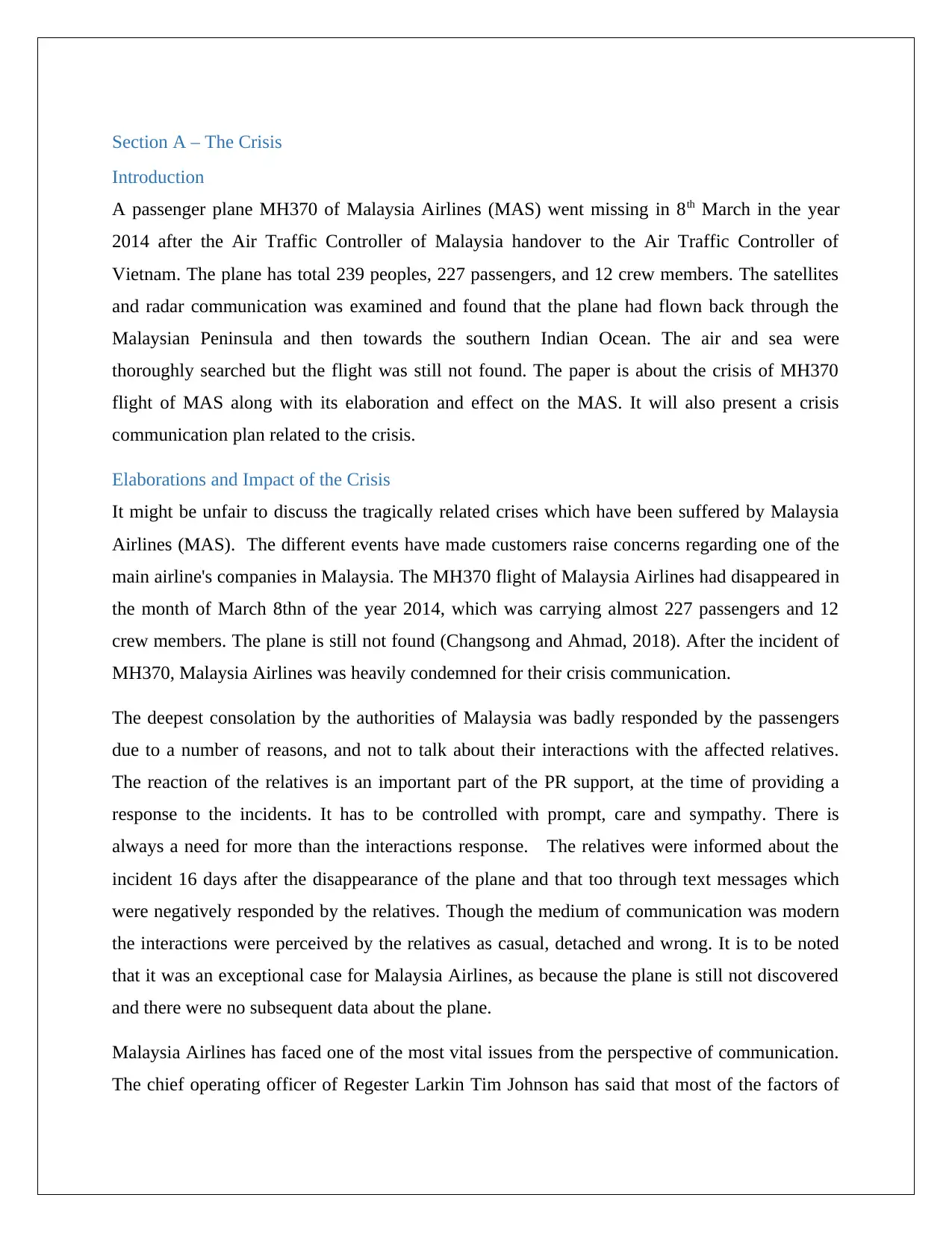
Section A – The Crisis
Introduction
A passenger plane MH370 of Malaysia Airlines (MAS) went missing in 8th March in the year
2014 after the Air Traffic Controller of Malaysia handover to the Air Traffic Controller of
Vietnam. The plane has total 239 peoples, 227 passengers, and 12 crew members. The satellites
and radar communication was examined and found that the plane had flown back through the
Malaysian Peninsula and then towards the southern Indian Ocean. The air and sea were
thoroughly searched but the flight was still not found. The paper is about the crisis of MH370
flight of MAS along with its elaboration and effect on the MAS. It will also present a crisis
communication plan related to the crisis.
Elaborations and Impact of the Crisis
It might be unfair to discuss the tragically related crises which have been suffered by Malaysia
Airlines (MAS). The different events have made customers raise concerns regarding one of the
main airline's companies in Malaysia. The MH370 flight of Malaysia Airlines had disappeared in
the month of March 8thn of the year 2014, which was carrying almost 227 passengers and 12
crew members. The plane is still not found (Changsong and Ahmad, 2018). After the incident of
MH370, Malaysia Airlines was heavily condemned for their crisis communication.
The deepest consolation by the authorities of Malaysia was badly responded by the passengers
due to a number of reasons, and not to talk about their interactions with the affected relatives.
The reaction of the relatives is an important part of the PR support, at the time of providing a
response to the incidents. It has to be controlled with prompt, care and sympathy. There is
always a need for more than the interactions response. The relatives were informed about the
incident 16 days after the disappearance of the plane and that too through text messages which
were negatively responded by the relatives. Though the medium of communication was modern
the interactions were perceived by the relatives as casual, detached and wrong. It is to be noted
that it was an exceptional case for Malaysia Airlines, as because the plane is still not discovered
and there were no subsequent data about the plane.
Malaysia Airlines has faced one of the most vital issues from the perspective of communication.
The chief operating officer of Regester Larkin Tim Johnson has said that most of the factors of
Introduction
A passenger plane MH370 of Malaysia Airlines (MAS) went missing in 8th March in the year
2014 after the Air Traffic Controller of Malaysia handover to the Air Traffic Controller of
Vietnam. The plane has total 239 peoples, 227 passengers, and 12 crew members. The satellites
and radar communication was examined and found that the plane had flown back through the
Malaysian Peninsula and then towards the southern Indian Ocean. The air and sea were
thoroughly searched but the flight was still not found. The paper is about the crisis of MH370
flight of MAS along with its elaboration and effect on the MAS. It will also present a crisis
communication plan related to the crisis.
Elaborations and Impact of the Crisis
It might be unfair to discuss the tragically related crises which have been suffered by Malaysia
Airlines (MAS). The different events have made customers raise concerns regarding one of the
main airline's companies in Malaysia. The MH370 flight of Malaysia Airlines had disappeared in
the month of March 8thn of the year 2014, which was carrying almost 227 passengers and 12
crew members. The plane is still not found (Changsong and Ahmad, 2018). After the incident of
MH370, Malaysia Airlines was heavily condemned for their crisis communication.
The deepest consolation by the authorities of Malaysia was badly responded by the passengers
due to a number of reasons, and not to talk about their interactions with the affected relatives.
The reaction of the relatives is an important part of the PR support, at the time of providing a
response to the incidents. It has to be controlled with prompt, care and sympathy. There is
always a need for more than the interactions response. The relatives were informed about the
incident 16 days after the disappearance of the plane and that too through text messages which
were negatively responded by the relatives. Though the medium of communication was modern
the interactions were perceived by the relatives as casual, detached and wrong. It is to be noted
that it was an exceptional case for Malaysia Airlines, as because the plane is still not discovered
and there were no subsequent data about the plane.
Malaysia Airlines has faced one of the most vital issues from the perspective of communication.
The chief operating officer of Regester Larkin Tim Johnson has said that most of the factors of
⊘ This is a preview!⊘
Do you want full access?
Subscribe today to unlock all pages.

Trusted by 1+ million students worldwide
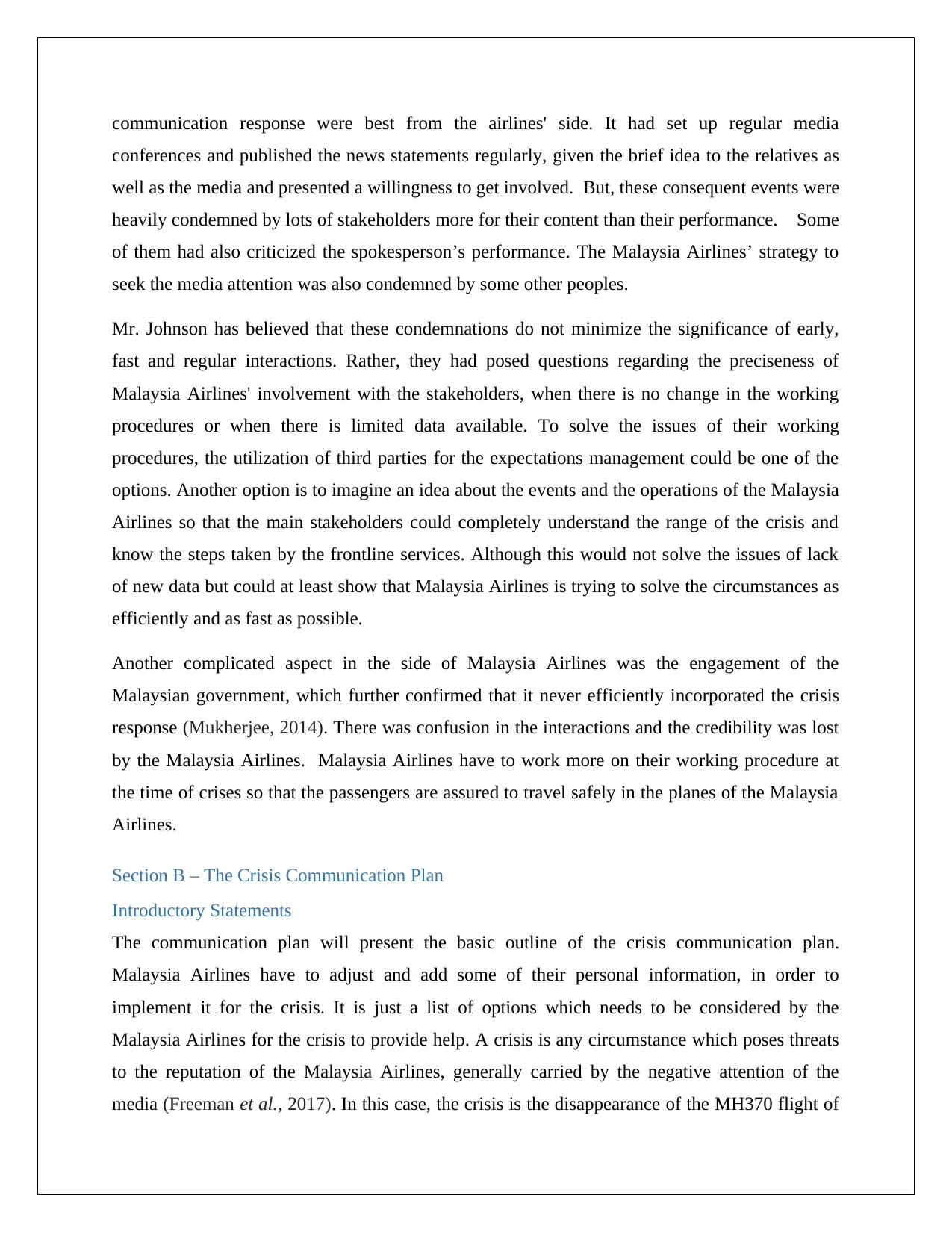
communication response were best from the airlines' side. It had set up regular media
conferences and published the news statements regularly, given the brief idea to the relatives as
well as the media and presented a willingness to get involved. But, these consequent events were
heavily condemned by lots of stakeholders more for their content than their performance. Some
of them had also criticized the spokesperson’s performance. The Malaysia Airlines’ strategy to
seek the media attention was also condemned by some other peoples.
Mr. Johnson has believed that these condemnations do not minimize the significance of early,
fast and regular interactions. Rather, they had posed questions regarding the preciseness of
Malaysia Airlines' involvement with the stakeholders, when there is no change in the working
procedures or when there is limited data available. To solve the issues of their working
procedures, the utilization of third parties for the expectations management could be one of the
options. Another option is to imagine an idea about the events and the operations of the Malaysia
Airlines so that the main stakeholders could completely understand the range of the crisis and
know the steps taken by the frontline services. Although this would not solve the issues of lack
of new data but could at least show that Malaysia Airlines is trying to solve the circumstances as
efficiently and as fast as possible.
Another complicated aspect in the side of Malaysia Airlines was the engagement of the
Malaysian government, which further confirmed that it never efficiently incorporated the crisis
response (Mukherjee, 2014). There was confusion in the interactions and the credibility was lost
by the Malaysia Airlines. Malaysia Airlines have to work more on their working procedure at
the time of crises so that the passengers are assured to travel safely in the planes of the Malaysia
Airlines.
Section B – The Crisis Communication Plan
Introductory Statements
The communication plan will present the basic outline of the crisis communication plan.
Malaysia Airlines have to adjust and add some of their personal information, in order to
implement it for the crisis. It is just a list of options which needs to be considered by the
Malaysia Airlines for the crisis to provide help. A crisis is any circumstance which poses threats
to the reputation of the Malaysia Airlines, generally carried by the negative attention of the
media (Freeman et al., 2017). In this case, the crisis is the disappearance of the MH370 flight of
conferences and published the news statements regularly, given the brief idea to the relatives as
well as the media and presented a willingness to get involved. But, these consequent events were
heavily condemned by lots of stakeholders more for their content than their performance. Some
of them had also criticized the spokesperson’s performance. The Malaysia Airlines’ strategy to
seek the media attention was also condemned by some other peoples.
Mr. Johnson has believed that these condemnations do not minimize the significance of early,
fast and regular interactions. Rather, they had posed questions regarding the preciseness of
Malaysia Airlines' involvement with the stakeholders, when there is no change in the working
procedures or when there is limited data available. To solve the issues of their working
procedures, the utilization of third parties for the expectations management could be one of the
options. Another option is to imagine an idea about the events and the operations of the Malaysia
Airlines so that the main stakeholders could completely understand the range of the crisis and
know the steps taken by the frontline services. Although this would not solve the issues of lack
of new data but could at least show that Malaysia Airlines is trying to solve the circumstances as
efficiently and as fast as possible.
Another complicated aspect in the side of Malaysia Airlines was the engagement of the
Malaysian government, which further confirmed that it never efficiently incorporated the crisis
response (Mukherjee, 2014). There was confusion in the interactions and the credibility was lost
by the Malaysia Airlines. Malaysia Airlines have to work more on their working procedure at
the time of crises so that the passengers are assured to travel safely in the planes of the Malaysia
Airlines.
Section B – The Crisis Communication Plan
Introductory Statements
The communication plan will present the basic outline of the crisis communication plan.
Malaysia Airlines have to adjust and add some of their personal information, in order to
implement it for the crisis. It is just a list of options which needs to be considered by the
Malaysia Airlines for the crisis to provide help. A crisis is any circumstance which poses threats
to the reputation of the Malaysia Airlines, generally carried by the negative attention of the
media (Freeman et al., 2017). In this case, the crisis is the disappearance of the MH370 flight of
Paraphrase This Document
Need a fresh take? Get an instant paraphrase of this document with our AI Paraphraser
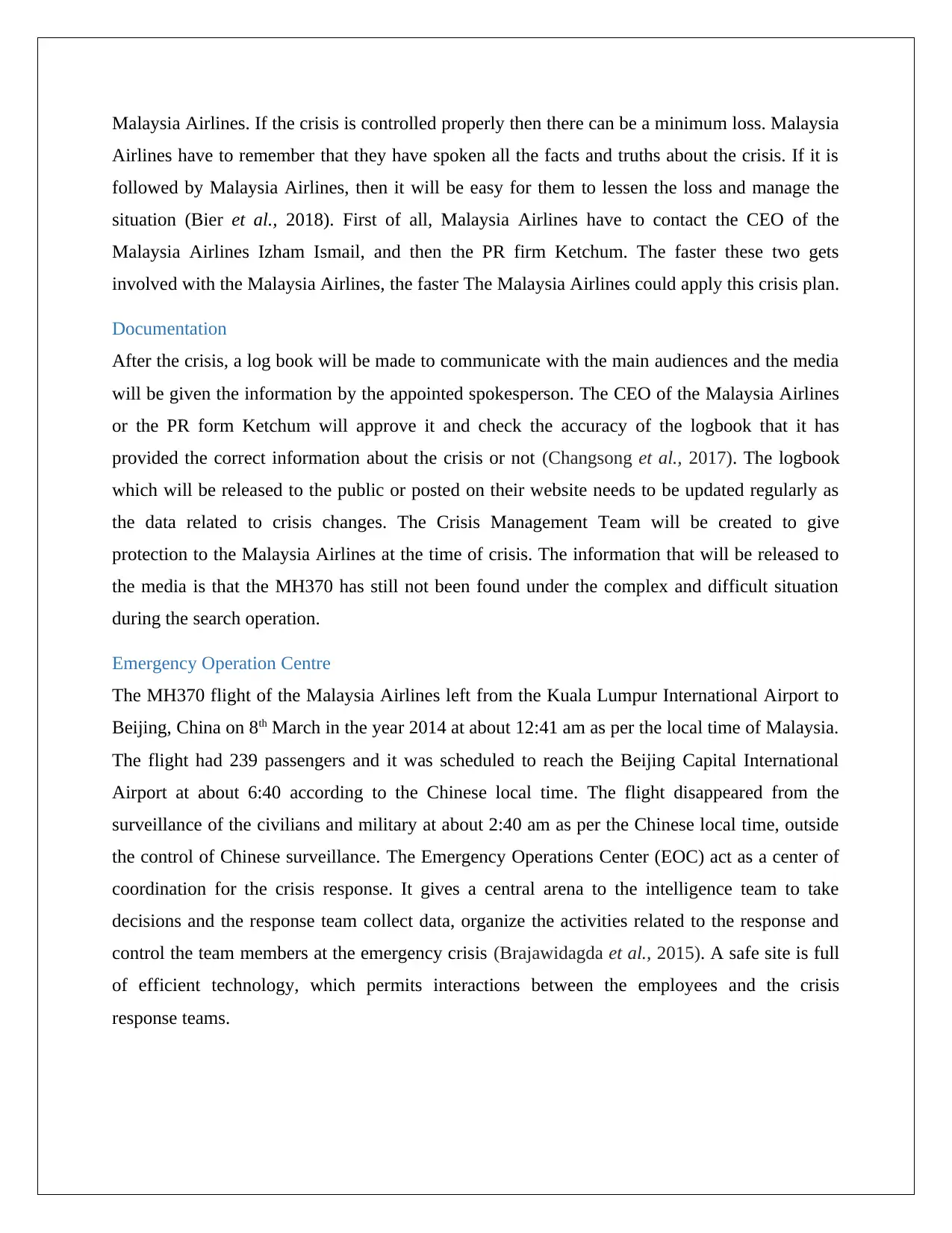
Malaysia Airlines. If the crisis is controlled properly then there can be a minimum loss. Malaysia
Airlines have to remember that they have spoken all the facts and truths about the crisis. If it is
followed by Malaysia Airlines, then it will be easy for them to lessen the loss and manage the
situation (Bier et al., 2018). First of all, Malaysia Airlines have to contact the CEO of the
Malaysia Airlines Izham Ismail, and then the PR firm Ketchum. The faster these two gets
involved with the Malaysia Airlines, the faster The Malaysia Airlines could apply this crisis plan.
Documentation
After the crisis, a log book will be made to communicate with the main audiences and the media
will be given the information by the appointed spokesperson. The CEO of the Malaysia Airlines
or the PR form Ketchum will approve it and check the accuracy of the logbook that it has
provided the correct information about the crisis or not (Changsong et al., 2017). The logbook
which will be released to the public or posted on their website needs to be updated regularly as
the data related to crisis changes. The Crisis Management Team will be created to give
protection to the Malaysia Airlines at the time of crisis. The information that will be released to
the media is that the MH370 has still not been found under the complex and difficult situation
during the search operation.
Emergency Operation Centre
The MH370 flight of the Malaysia Airlines left from the Kuala Lumpur International Airport to
Beijing, China on 8th March in the year 2014 at about 12:41 am as per the local time of Malaysia.
The flight had 239 passengers and it was scheduled to reach the Beijing Capital International
Airport at about 6:40 according to the Chinese local time. The flight disappeared from the
surveillance of the civilians and military at about 2:40 am as per the Chinese local time, outside
the control of Chinese surveillance. The Emergency Operations Center (EOC) act as a center of
coordination for the crisis response. It gives a central arena to the intelligence team to take
decisions and the response team collect data, organize the activities related to the response and
control the team members at the emergency crisis (Brajawidagda et al., 2015). A safe site is full
of efficient technology, which permits interactions between the employees and the crisis
response teams.
Airlines have to remember that they have spoken all the facts and truths about the crisis. If it is
followed by Malaysia Airlines, then it will be easy for them to lessen the loss and manage the
situation (Bier et al., 2018). First of all, Malaysia Airlines have to contact the CEO of the
Malaysia Airlines Izham Ismail, and then the PR firm Ketchum. The faster these two gets
involved with the Malaysia Airlines, the faster The Malaysia Airlines could apply this crisis plan.
Documentation
After the crisis, a log book will be made to communicate with the main audiences and the media
will be given the information by the appointed spokesperson. The CEO of the Malaysia Airlines
or the PR form Ketchum will approve it and check the accuracy of the logbook that it has
provided the correct information about the crisis or not (Changsong et al., 2017). The logbook
which will be released to the public or posted on their website needs to be updated regularly as
the data related to crisis changes. The Crisis Management Team will be created to give
protection to the Malaysia Airlines at the time of crisis. The information that will be released to
the media is that the MH370 has still not been found under the complex and difficult situation
during the search operation.
Emergency Operation Centre
The MH370 flight of the Malaysia Airlines left from the Kuala Lumpur International Airport to
Beijing, China on 8th March in the year 2014 at about 12:41 am as per the local time of Malaysia.
The flight had 239 passengers and it was scheduled to reach the Beijing Capital International
Airport at about 6:40 according to the Chinese local time. The flight disappeared from the
surveillance of the civilians and military at about 2:40 am as per the Chinese local time, outside
the control of Chinese surveillance. The Emergency Operations Center (EOC) act as a center of
coordination for the crisis response. It gives a central arena to the intelligence team to take
decisions and the response team collect data, organize the activities related to the response and
control the team members at the emergency crisis (Brajawidagda et al., 2015). A safe site is full
of efficient technology, which permits interactions between the employees and the crisis
response teams.

The Core Crisis Management Team
The main responsibility of this team is to recognize the actions that would be taken by them. The
team has to include those persons who are significant for the circumstance. The CEO of MAS
Izham Ismail, the Public Relations firm Ketchum, the Vice President Dean Decko, the Senior
manager from the division in charge of the area of crisis, the safety officer, the company lawyer
and maybe some of the eyewitnesses. The duty of this team is to make an action plan and decides
the spokesperson (Park et al., 2016).
Team Member Responsibilities
One of the biggest aspects which will decide the success or failure of the crisis communication
plan of Malaysia Airlines is the strength of the team members of the Crisis Management Team.
In order to build a strong team, it is vital for Malaysia Airlines to appoint the correct person in
the leadership position who will supervise the team and the strengths of the individuals. The
responsibility of the Crisis Management Team is to control and lead the members of the team,
exchange vital information to all the departments of Malaysia Airlines and evaluate the issue and
possible damages. The department heads, an executive team, a member of the Board of
Directors, marketing and communications managers and members of Human Resources make a
Crisis Management Team. This team will provide help to evaluate the crisis, decide an action
plan and apply it to lessen the damages due to the crisis. It is important for them to have the
capability of solving issues as well the critical thoughts (Xu and Zhang, 2018). This will make
sure that they find the best solutions in the most effective method. All the members of the team
have to be competent so that they can evaluate and solve the crisis. Each member will have to
address the audience and share data about the crisis. Lack of good communication skills in any
of the team members will be harmful to the team. The leader of the team has to capable to pass a
strong message and the team has to clear about the message. It is vital for the team members to
work together to find the best strategy and solutions to the crisis. They could not work with the
team if any member of the team will be working against the team. To get the best outcomes,
every member of the team have to work together in order to achieve the same target.
Team Resource Requirements
The technological development of social media by the Malaysia Airlines for their crisis
communication has changed the traditional method of reporting of the crisis. The crisis
The main responsibility of this team is to recognize the actions that would be taken by them. The
team has to include those persons who are significant for the circumstance. The CEO of MAS
Izham Ismail, the Public Relations firm Ketchum, the Vice President Dean Decko, the Senior
manager from the division in charge of the area of crisis, the safety officer, the company lawyer
and maybe some of the eyewitnesses. The duty of this team is to make an action plan and decides
the spokesperson (Park et al., 2016).
Team Member Responsibilities
One of the biggest aspects which will decide the success or failure of the crisis communication
plan of Malaysia Airlines is the strength of the team members of the Crisis Management Team.
In order to build a strong team, it is vital for Malaysia Airlines to appoint the correct person in
the leadership position who will supervise the team and the strengths of the individuals. The
responsibility of the Crisis Management Team is to control and lead the members of the team,
exchange vital information to all the departments of Malaysia Airlines and evaluate the issue and
possible damages. The department heads, an executive team, a member of the Board of
Directors, marketing and communications managers and members of Human Resources make a
Crisis Management Team. This team will provide help to evaluate the crisis, decide an action
plan and apply it to lessen the damages due to the crisis. It is important for them to have the
capability of solving issues as well the critical thoughts (Xu and Zhang, 2018). This will make
sure that they find the best solutions in the most effective method. All the members of the team
have to be competent so that they can evaluate and solve the crisis. Each member will have to
address the audience and share data about the crisis. Lack of good communication skills in any
of the team members will be harmful to the team. The leader of the team has to capable to pass a
strong message and the team has to clear about the message. It is vital for the team members to
work together to find the best strategy and solutions to the crisis. They could not work with the
team if any member of the team will be working against the team. To get the best outcomes,
every member of the team have to work together in order to achieve the same target.
Team Resource Requirements
The technological development of social media by the Malaysia Airlines for their crisis
communication has changed the traditional method of reporting of the crisis. The crisis
⊘ This is a preview!⊘
Do you want full access?
Subscribe today to unlock all pages.

Trusted by 1+ million students worldwide
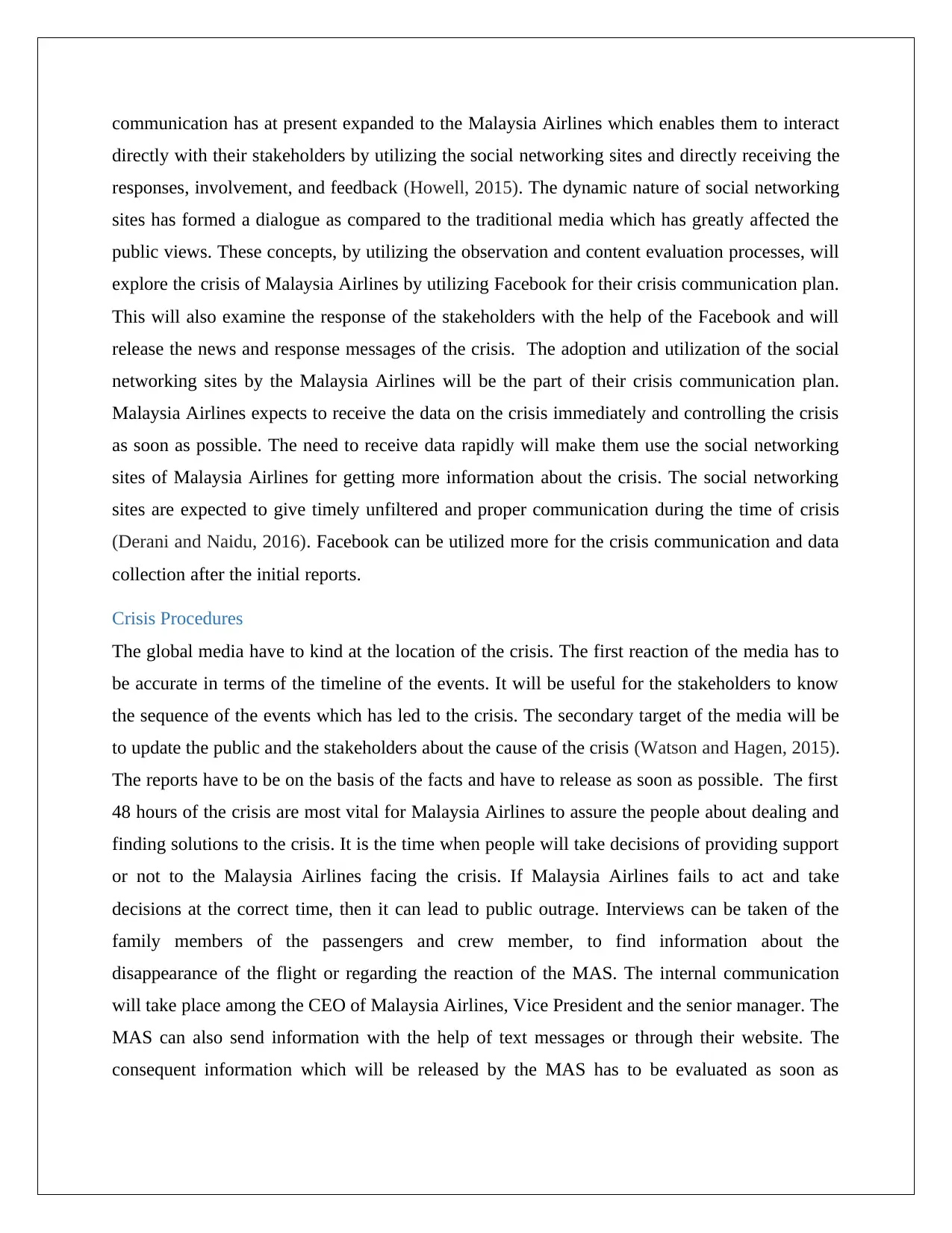
communication has at present expanded to the Malaysia Airlines which enables them to interact
directly with their stakeholders by utilizing the social networking sites and directly receiving the
responses, involvement, and feedback (Howell, 2015). The dynamic nature of social networking
sites has formed a dialogue as compared to the traditional media which has greatly affected the
public views. These concepts, by utilizing the observation and content evaluation processes, will
explore the crisis of Malaysia Airlines by utilizing Facebook for their crisis communication plan.
This will also examine the response of the stakeholders with the help of the Facebook and will
release the news and response messages of the crisis. The adoption and utilization of the social
networking sites by the Malaysia Airlines will be the part of their crisis communication plan.
Malaysia Airlines expects to receive the data on the crisis immediately and controlling the crisis
as soon as possible. The need to receive data rapidly will make them use the social networking
sites of Malaysia Airlines for getting more information about the crisis. The social networking
sites are expected to give timely unfiltered and proper communication during the time of crisis
(Derani and Naidu, 2016). Facebook can be utilized more for the crisis communication and data
collection after the initial reports.
Crisis Procedures
The global media have to kind at the location of the crisis. The first reaction of the media has to
be accurate in terms of the timeline of the events. It will be useful for the stakeholders to know
the sequence of the events which has led to the crisis. The secondary target of the media will be
to update the public and the stakeholders about the cause of the crisis (Watson and Hagen, 2015).
The reports have to be on the basis of the facts and have to release as soon as possible. The first
48 hours of the crisis are most vital for Malaysia Airlines to assure the people about dealing and
finding solutions to the crisis. It is the time when people will take decisions of providing support
or not to the Malaysia Airlines facing the crisis. If Malaysia Airlines fails to act and take
decisions at the correct time, then it can lead to public outrage. Interviews can be taken of the
family members of the passengers and crew member, to find information about the
disappearance of the flight or regarding the reaction of the MAS. The internal communication
will take place among the CEO of Malaysia Airlines, Vice President and the senior manager. The
MAS can also send information with the help of text messages or through their website. The
consequent information which will be released by the MAS has to be evaluated as soon as
directly with their stakeholders by utilizing the social networking sites and directly receiving the
responses, involvement, and feedback (Howell, 2015). The dynamic nature of social networking
sites has formed a dialogue as compared to the traditional media which has greatly affected the
public views. These concepts, by utilizing the observation and content evaluation processes, will
explore the crisis of Malaysia Airlines by utilizing Facebook for their crisis communication plan.
This will also examine the response of the stakeholders with the help of the Facebook and will
release the news and response messages of the crisis. The adoption and utilization of the social
networking sites by the Malaysia Airlines will be the part of their crisis communication plan.
Malaysia Airlines expects to receive the data on the crisis immediately and controlling the crisis
as soon as possible. The need to receive data rapidly will make them use the social networking
sites of Malaysia Airlines for getting more information about the crisis. The social networking
sites are expected to give timely unfiltered and proper communication during the time of crisis
(Derani and Naidu, 2016). Facebook can be utilized more for the crisis communication and data
collection after the initial reports.
Crisis Procedures
The global media have to kind at the location of the crisis. The first reaction of the media has to
be accurate in terms of the timeline of the events. It will be useful for the stakeholders to know
the sequence of the events which has led to the crisis. The secondary target of the media will be
to update the public and the stakeholders about the cause of the crisis (Watson and Hagen, 2015).
The reports have to be on the basis of the facts and have to release as soon as possible. The first
48 hours of the crisis are most vital for Malaysia Airlines to assure the people about dealing and
finding solutions to the crisis. It is the time when people will take decisions of providing support
or not to the Malaysia Airlines facing the crisis. If Malaysia Airlines fails to act and take
decisions at the correct time, then it can lead to public outrage. Interviews can be taken of the
family members of the passengers and crew member, to find information about the
disappearance of the flight or regarding the reaction of the MAS. The internal communication
will take place among the CEO of Malaysia Airlines, Vice President and the senior manager. The
MAS can also send information with the help of text messages or through their website. The
consequent information which will be released by the MAS has to be evaluated as soon as
Paraphrase This Document
Need a fresh take? Get an instant paraphrase of this document with our AI Paraphraser
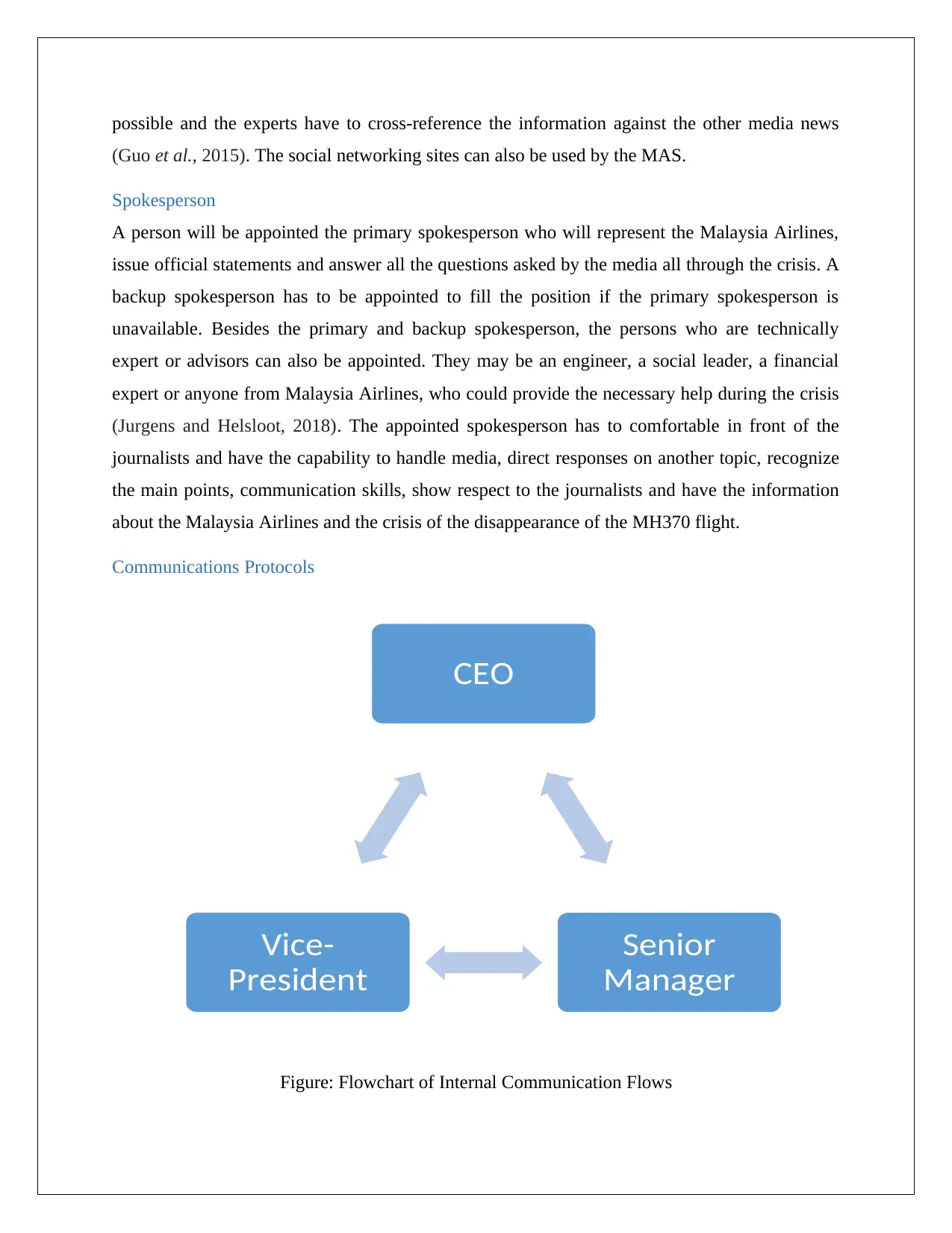
possible and the experts have to cross-reference the information against the other media news
(Guo et al., 2015). The social networking sites can also be used by the MAS.
Spokesperson
A person will be appointed the primary spokesperson who will represent the Malaysia Airlines,
issue official statements and answer all the questions asked by the media all through the crisis. A
backup spokesperson has to be appointed to fill the position if the primary spokesperson is
unavailable. Besides the primary and backup spokesperson, the persons who are technically
expert or advisors can also be appointed. They may be an engineer, a social leader, a financial
expert or anyone from Malaysia Airlines, who could provide the necessary help during the crisis
(Jurgens and Helsloot, 2018). The appointed spokesperson has to comfortable in front of the
journalists and have the capability to handle media, direct responses on another topic, recognize
the main points, communication skills, show respect to the journalists and have the information
about the Malaysia Airlines and the crisis of the disappearance of the MH370 flight.
Communications Protocols
Figure: Flowchart of Internal Communication Flows
CEO
Senior
Manager
Vice-
President
(Guo et al., 2015). The social networking sites can also be used by the MAS.
Spokesperson
A person will be appointed the primary spokesperson who will represent the Malaysia Airlines,
issue official statements and answer all the questions asked by the media all through the crisis. A
backup spokesperson has to be appointed to fill the position if the primary spokesperson is
unavailable. Besides the primary and backup spokesperson, the persons who are technically
expert or advisors can also be appointed. They may be an engineer, a social leader, a financial
expert or anyone from Malaysia Airlines, who could provide the necessary help during the crisis
(Jurgens and Helsloot, 2018). The appointed spokesperson has to comfortable in front of the
journalists and have the capability to handle media, direct responses on another topic, recognize
the main points, communication skills, show respect to the journalists and have the information
about the Malaysia Airlines and the crisis of the disappearance of the MH370 flight.
Communications Protocols
Figure: Flowchart of Internal Communication Flows
CEO
Senior
Manager
Vice-
President

(Source: (Jansen et al., 2016)
⊘ This is a preview!⊘
Do you want full access?
Subscribe today to unlock all pages.

Trusted by 1+ million students worldwide
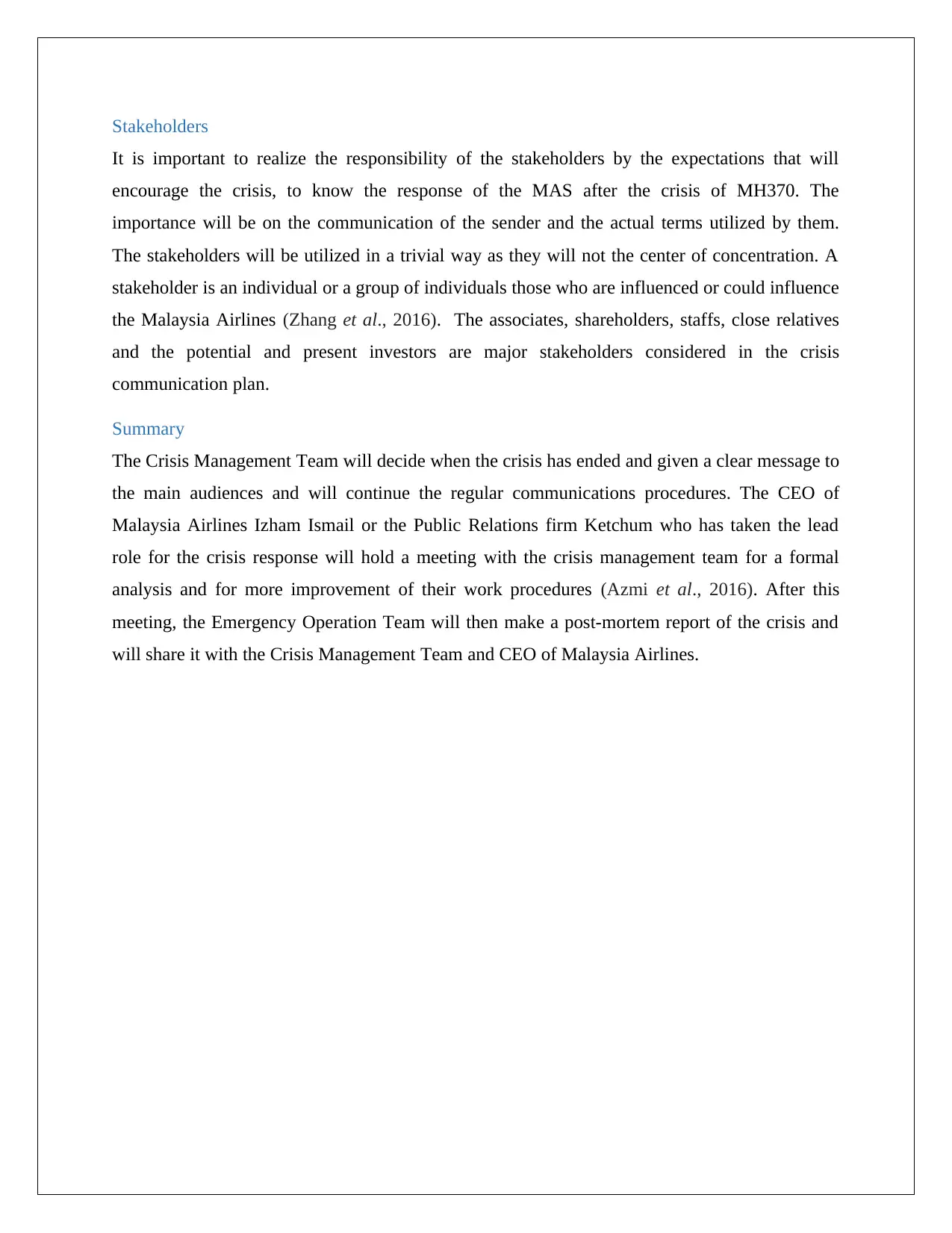
Stakeholders
It is important to realize the responsibility of the stakeholders by the expectations that will
encourage the crisis, to know the response of the MAS after the crisis of MH370. The
importance will be on the communication of the sender and the actual terms utilized by them.
The stakeholders will be utilized in a trivial way as they will not the center of concentration. A
stakeholder is an individual or a group of individuals those who are influenced or could influence
the Malaysia Airlines (Zhang et al., 2016). The associates, shareholders, staffs, close relatives
and the potential and present investors are major stakeholders considered in the crisis
communication plan.
Summary
The Crisis Management Team will decide when the crisis has ended and given a clear message to
the main audiences and will continue the regular communications procedures. The CEO of
Malaysia Airlines Izham Ismail or the Public Relations firm Ketchum who has taken the lead
role for the crisis response will hold a meeting with the crisis management team for a formal
analysis and for more improvement of their work procedures (Azmi et al., 2016). After this
meeting, the Emergency Operation Team will then make a post-mortem report of the crisis and
will share it with the Crisis Management Team and CEO of Malaysia Airlines.
It is important to realize the responsibility of the stakeholders by the expectations that will
encourage the crisis, to know the response of the MAS after the crisis of MH370. The
importance will be on the communication of the sender and the actual terms utilized by them.
The stakeholders will be utilized in a trivial way as they will not the center of concentration. A
stakeholder is an individual or a group of individuals those who are influenced or could influence
the Malaysia Airlines (Zhang et al., 2016). The associates, shareholders, staffs, close relatives
and the potential and present investors are major stakeholders considered in the crisis
communication plan.
Summary
The Crisis Management Team will decide when the crisis has ended and given a clear message to
the main audiences and will continue the regular communications procedures. The CEO of
Malaysia Airlines Izham Ismail or the Public Relations firm Ketchum who has taken the lead
role for the crisis response will hold a meeting with the crisis management team for a formal
analysis and for more improvement of their work procedures (Azmi et al., 2016). After this
meeting, the Emergency Operation Team will then make a post-mortem report of the crisis and
will share it with the Crisis Management Team and CEO of Malaysia Airlines.
Paraphrase This Document
Need a fresh take? Get an instant paraphrase of this document with our AI Paraphraser
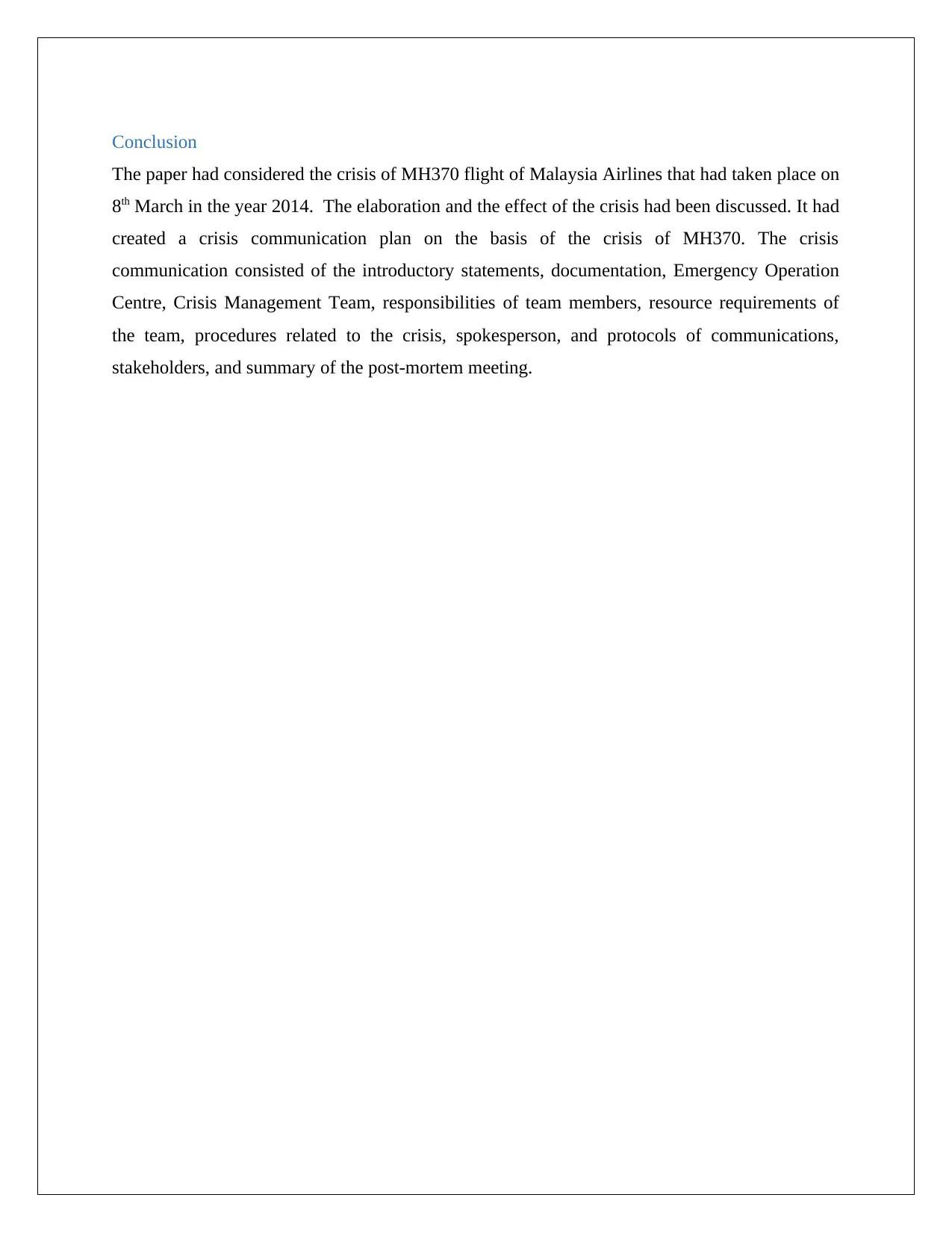
Conclusion
The paper had considered the crisis of MH370 flight of Malaysia Airlines that had taken place on
8th March in the year 2014. The elaboration and the effect of the crisis had been discussed. It had
created a crisis communication plan on the basis of the crisis of MH370. The crisis
communication consisted of the introductory statements, documentation, Emergency Operation
Centre, Crisis Management Team, responsibilities of team members, resource requirements of
the team, procedures related to the crisis, spokesperson, and protocols of communications,
stakeholders, and summary of the post-mortem meeting.
The paper had considered the crisis of MH370 flight of Malaysia Airlines that had taken place on
8th March in the year 2014. The elaboration and the effect of the crisis had been discussed. It had
created a crisis communication plan on the basis of the crisis of MH370. The crisis
communication consisted of the introductory statements, documentation, Emergency Operation
Centre, Crisis Management Team, responsibilities of team members, resource requirements of
the team, procedures related to the crisis, spokesperson, and protocols of communications,
stakeholders, and summary of the post-mortem meeting.
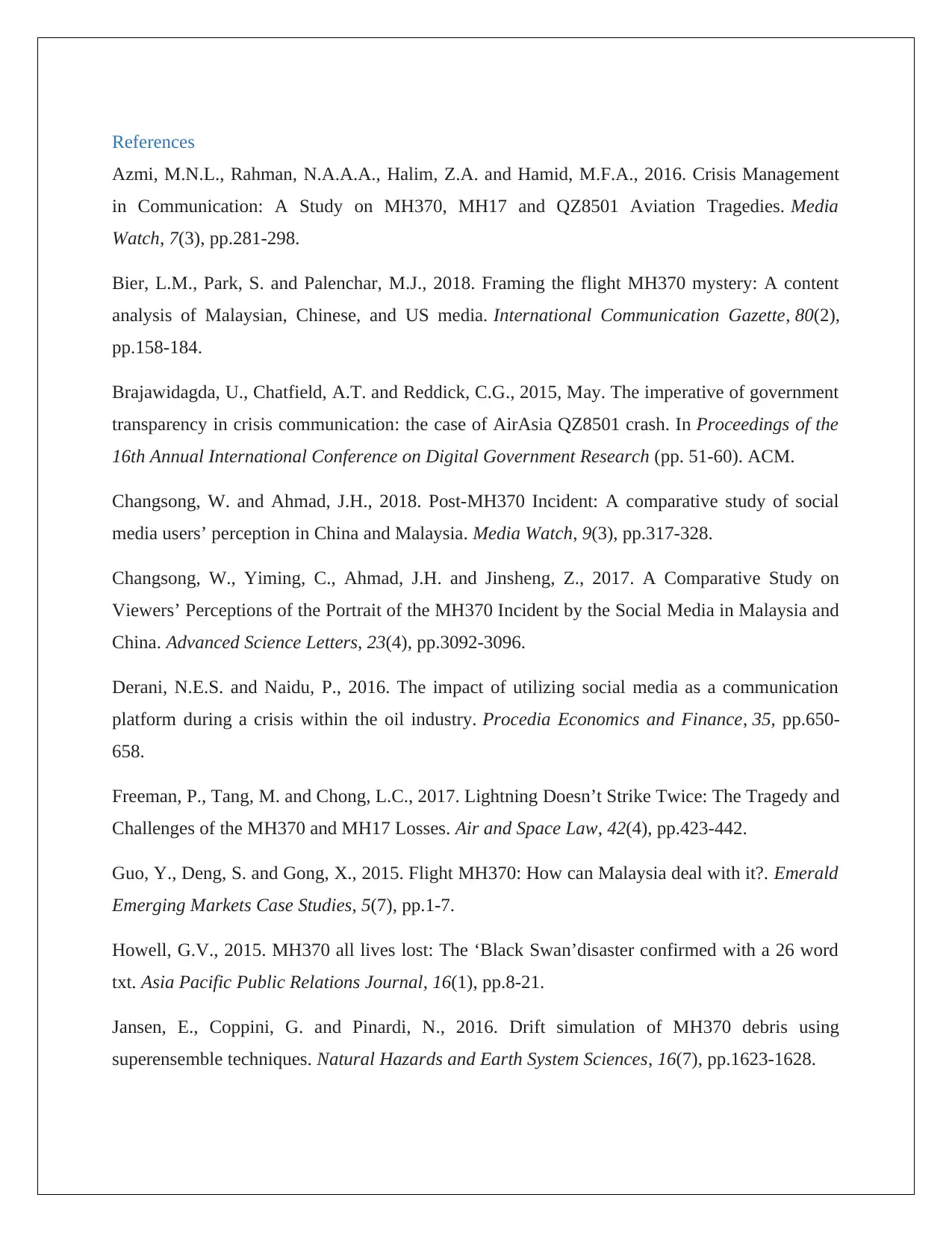
References
Azmi, M.N.L., Rahman, N.A.A.A., Halim, Z.A. and Hamid, M.F.A., 2016. Crisis Management
in Communication: A Study on MH370, MH17 and QZ8501 Aviation Tragedies. Media
Watch, 7(3), pp.281-298.
Bier, L.M., Park, S. and Palenchar, M.J., 2018. Framing the flight MH370 mystery: A content
analysis of Malaysian, Chinese, and US media. International Communication Gazette, 80(2),
pp.158-184.
Brajawidagda, U., Chatfield, A.T. and Reddick, C.G., 2015, May. The imperative of government
transparency in crisis communication: the case of AirAsia QZ8501 crash. In Proceedings of the
16th Annual International Conference on Digital Government Research (pp. 51-60). ACM.
Changsong, W. and Ahmad, J.H., 2018. Post-MH370 Incident: A comparative study of social
media users’ perception in China and Malaysia. Media Watch, 9(3), pp.317-328.
Changsong, W., Yiming, C., Ahmad, J.H. and Jinsheng, Z., 2017. A Comparative Study on
Viewers’ Perceptions of the Portrait of the MH370 Incident by the Social Media in Malaysia and
China. Advanced Science Letters, 23(4), pp.3092-3096.
Derani, N.E.S. and Naidu, P., 2016. The impact of utilizing social media as a communication
platform during a crisis within the oil industry. Procedia Economics and Finance, 35, pp.650-
658.
Freeman, P., Tang, M. and Chong, L.C., 2017. Lightning Doesn’t Strike Twice: The Tragedy and
Challenges of the MH370 and MH17 Losses. Air and Space Law, 42(4), pp.423-442.
Guo, Y., Deng, S. and Gong, X., 2015. Flight MH370: How can Malaysia deal with it?. Emerald
Emerging Markets Case Studies, 5(7), pp.1-7.
Howell, G.V., 2015. MH370 all lives lost: The ‘Black Swan’disaster confirmed with a 26 word
txt. Asia Pacific Public Relations Journal, 16(1), pp.8-21.
Jansen, E., Coppini, G. and Pinardi, N., 2016. Drift simulation of MH370 debris using
superensemble techniques. Natural Hazards and Earth System Sciences, 16(7), pp.1623-1628.
Azmi, M.N.L., Rahman, N.A.A.A., Halim, Z.A. and Hamid, M.F.A., 2016. Crisis Management
in Communication: A Study on MH370, MH17 and QZ8501 Aviation Tragedies. Media
Watch, 7(3), pp.281-298.
Bier, L.M., Park, S. and Palenchar, M.J., 2018. Framing the flight MH370 mystery: A content
analysis of Malaysian, Chinese, and US media. International Communication Gazette, 80(2),
pp.158-184.
Brajawidagda, U., Chatfield, A.T. and Reddick, C.G., 2015, May. The imperative of government
transparency in crisis communication: the case of AirAsia QZ8501 crash. In Proceedings of the
16th Annual International Conference on Digital Government Research (pp. 51-60). ACM.
Changsong, W. and Ahmad, J.H., 2018. Post-MH370 Incident: A comparative study of social
media users’ perception in China and Malaysia. Media Watch, 9(3), pp.317-328.
Changsong, W., Yiming, C., Ahmad, J.H. and Jinsheng, Z., 2017. A Comparative Study on
Viewers’ Perceptions of the Portrait of the MH370 Incident by the Social Media in Malaysia and
China. Advanced Science Letters, 23(4), pp.3092-3096.
Derani, N.E.S. and Naidu, P., 2016. The impact of utilizing social media as a communication
platform during a crisis within the oil industry. Procedia Economics and Finance, 35, pp.650-
658.
Freeman, P., Tang, M. and Chong, L.C., 2017. Lightning Doesn’t Strike Twice: The Tragedy and
Challenges of the MH370 and MH17 Losses. Air and Space Law, 42(4), pp.423-442.
Guo, Y., Deng, S. and Gong, X., 2015. Flight MH370: How can Malaysia deal with it?. Emerald
Emerging Markets Case Studies, 5(7), pp.1-7.
Howell, G.V., 2015. MH370 all lives lost: The ‘Black Swan’disaster confirmed with a 26 word
txt. Asia Pacific Public Relations Journal, 16(1), pp.8-21.
Jansen, E., Coppini, G. and Pinardi, N., 2016. Drift simulation of MH370 debris using
superensemble techniques. Natural Hazards and Earth System Sciences, 16(7), pp.1623-1628.
⊘ This is a preview!⊘
Do you want full access?
Subscribe today to unlock all pages.

Trusted by 1+ million students worldwide
1 out of 13
Related Documents
Your All-in-One AI-Powered Toolkit for Academic Success.
+13062052269
info@desklib.com
Available 24*7 on WhatsApp / Email
![[object Object]](/_next/static/media/star-bottom.7253800d.svg)
Unlock your academic potential
Copyright © 2020–2025 A2Z Services. All Rights Reserved. Developed and managed by ZUCOL.





